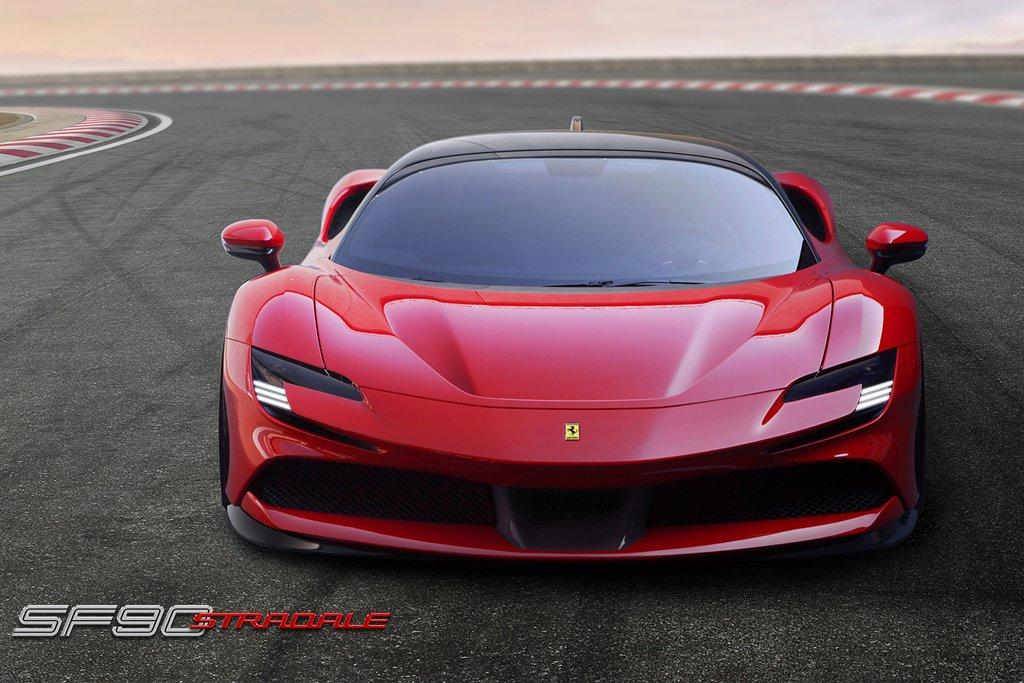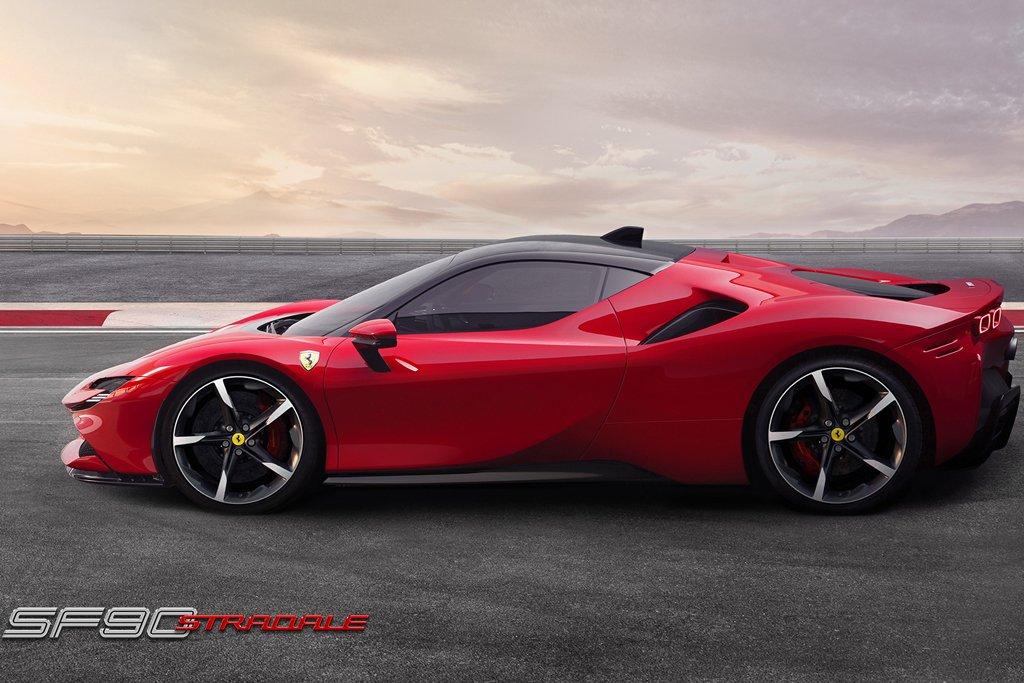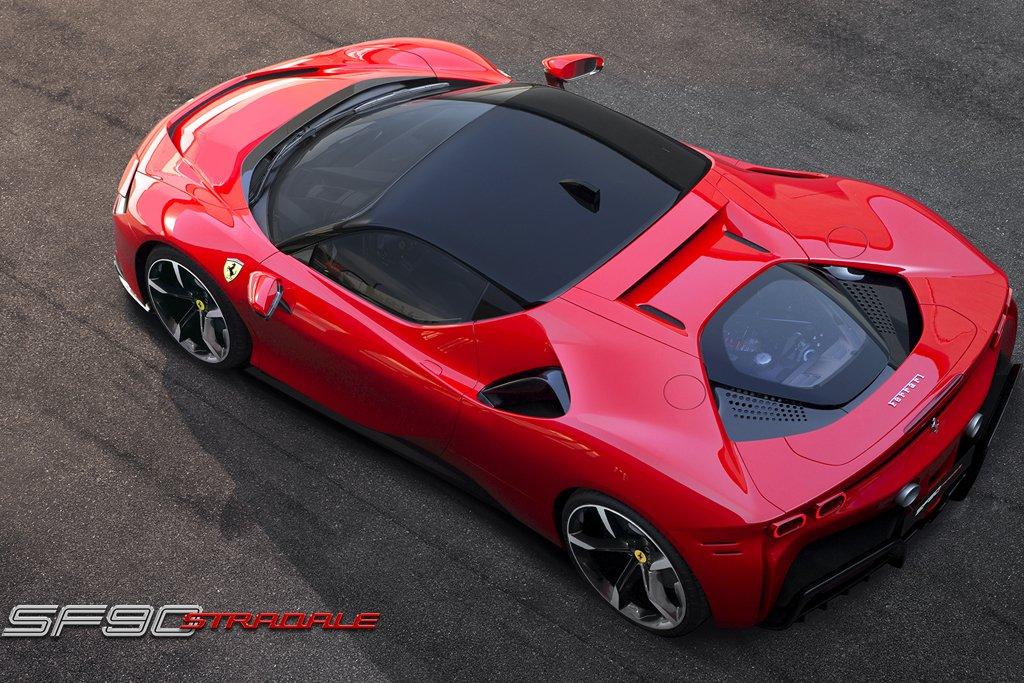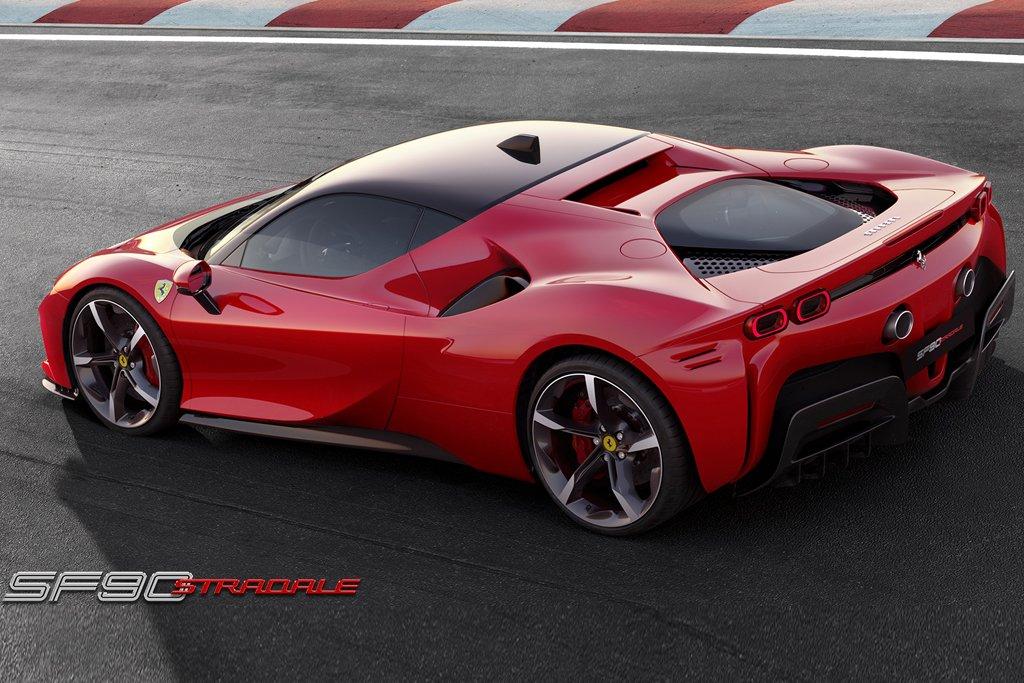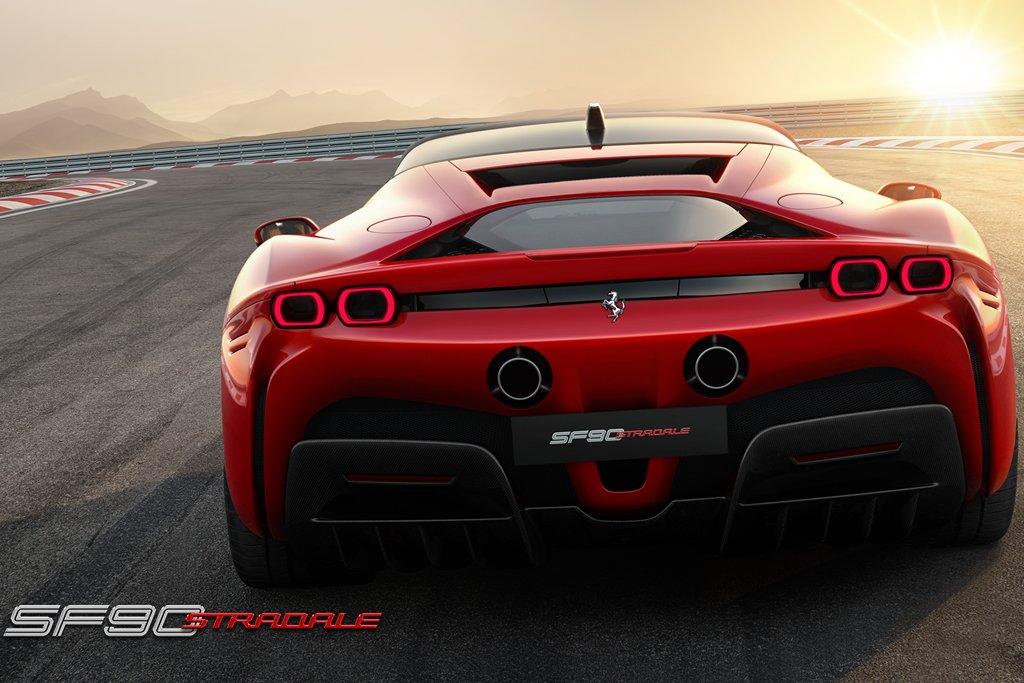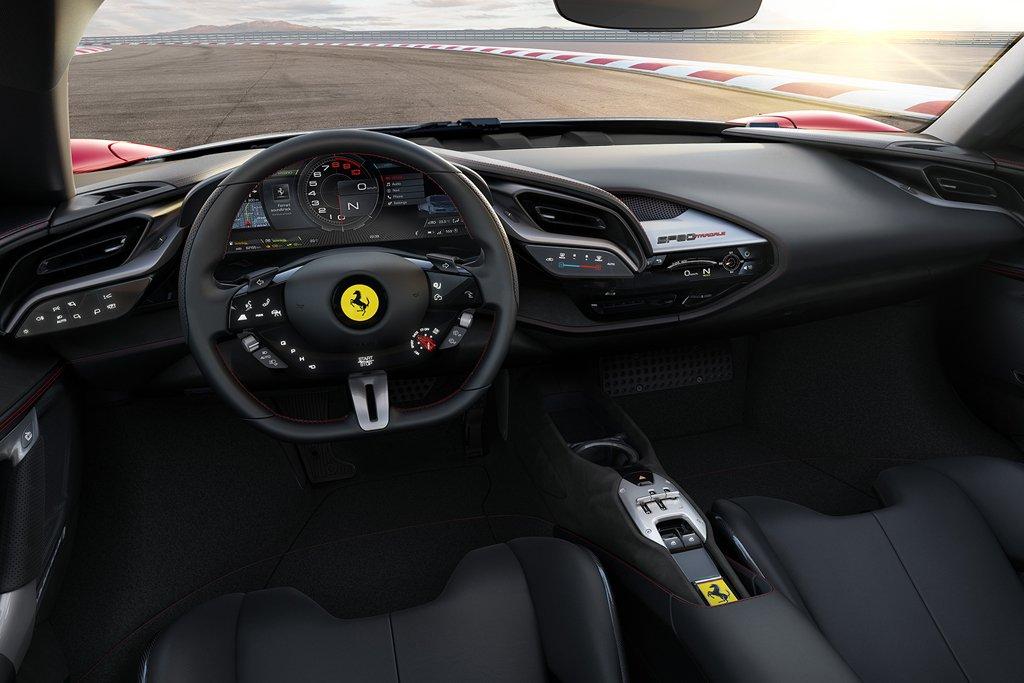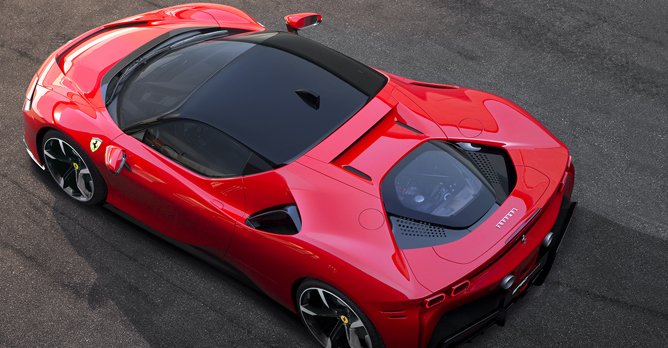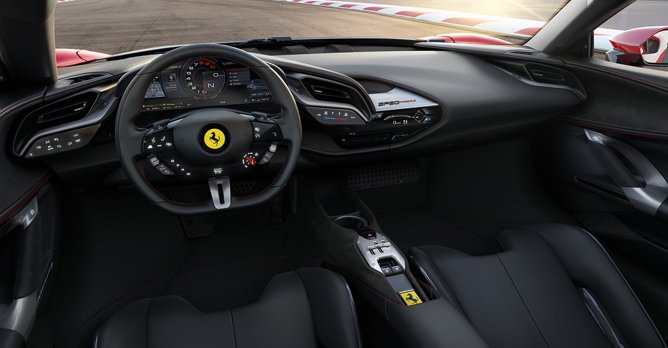Ferrari unveils the new SF90 Stradale
31 May 2019|4,706 views
The new model is extreme on every level and represents a true paradigm shift, because it delivers unprecedented performance for a production car. Figures such as 986bhp and 390kg of downforce at 250km/h not only put the SF90 Stradale at the top of its segment, but also mean that a V8 is the top-of-the-range model for the first time in the marque's history.
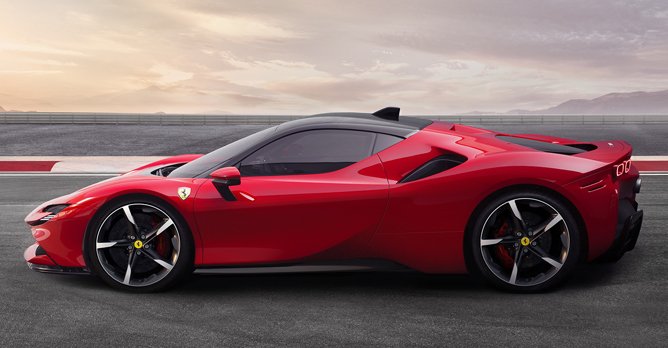
A brilliant encapsulation of the most advanced technologies developed in Maranello, the SF90 Stradale is also the perfect demonstration of how Ferrari immediately transitions the knowledge and skills it acquires in competition to its production cars.
The SF90 Stradale has a 90-degree V8 turbo engine capable of delivering 769bhp, the highest power output of any eight-cylinder in Ferrari history. The remaining 217bhp is delivered by three electric motors, one at the rear, known as the MGUK (Motor Generator Unit, Kinetic) due to its derivation from the Formula One application, located between the engine and the new eight-speed dual-clutch transmission on the rear axle, and two on the front axle.
This sophisticated system does not, however, make for a more complicated driving experience. Quite the opposite, in fact - the driver simply has to select one of the four power unit modes, and then just concentrate on driving.
The sophisticated control logic takes care of the rest, managing the flow of power between the V8, the electric motors and the batteries.
The SF90 Stradale is also the first Ferrari sports car to be equipped with 4WD, a step necessary to allow the incredible power unleashed by the hybrid powertrain to be fully exploited, ensuring the car has become the new benchmark for standing starts: 0-100km/h in 2.5 sec and 0-200km/h in just 6.7 seconds.
Ferrari's engineers were able to further broaden the spectrum of dynamic controls by introducing the full-electric front axle, known as the RAC-e (electronic cornering set-up regulator). As well as exclusively providing propulsion in electric drive, the two front motors independently control the torque delivered to the two wheels, extending the concept of Torque Vectoring.
Fully integrated into the car's vehicle dynamics controls, the RAC-e governs the distribution of torque, making driving on the limit much simpler and easier.
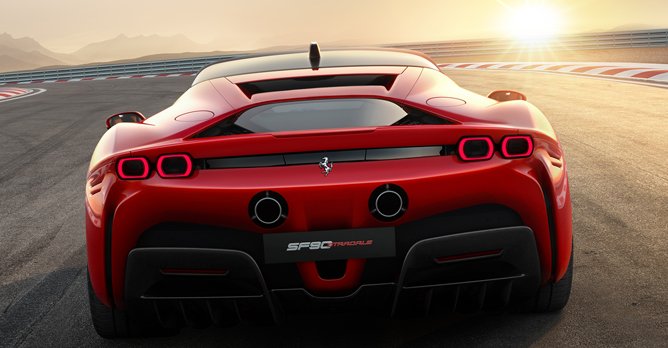
 The SF90 Stradale is now the new benchmark for downforce and efficiency in high-performance road cars The introduction of this hybrid architecture was a challenge with regard to managing the additional weight which was resolved by an obsessive attention to detail and the overall optimisation of the whole of the car.
The SF90 Stradale is now the new benchmark for downforce and efficiency in high-performance road cars The introduction of this hybrid architecture was a challenge with regard to managing the additional weight which was resolved by an obsessive attention to detail and the overall optimisation of the whole of the car.
For maximum performance in terms of overall weight, rigidity and centre of gravity, the chassis and bodyshell of the SF90 Stradale is all new, built using multi-material technology, including, for example, carbon fibre. The development of a hybrid car of this kind demanded the development of a series of innovative aerodynamic solutions.
The significant boost in the power unit's performance brought with it an increase in the amount of heat energy to be dissipated and required the development team to carry out an in-depth review of the aerodynamic flows on the radiating masses. It also demanded new solutions to increase downforce efficiently and guarantee maximum stability at all speeds and in all driving conditions.
Particularly noteworthy is the innovative shut-off Gurney, a patented active system located at the rear of the car, which regulates the air flow over the upper body, reducing drag at high speeds with low lateral dynamics loads and increasing downforce in corners, under braking and during changes of direction.
The new car is epoch-changing from a stylistic perspective as it completely rewrites the mid-rear-engined sports berlinetta proportions introduced on the 360 Modena 20 years ago, instead taking its inspiration from Ferrari's recent supercars.
A good example is the cockpit, which has a smaller frontal section and is placed closer to the front of the car to reduce drag. This was also achieved without impacting on-board comfort.
The track-derived 'eyes on the road, hands on the wheel' philosophy takes on a truly central role for the first time too, significantly influencing the ergonomics and styling of the interior. The result is an HMI (Human-Machine Interface) and interior layout concept that are a complete departure from previous models.
Another major innovation is the steering wheel, which now has a touchpad and a series of haptic buttons that allow the driver to control virtually every aspect of the car using just their thumbs.
The central instrument cluster is now entirely digital with the first automotive application of a 16-inch curved HD screen, which can be fully configured and controlled using the controls on the steering wheel.
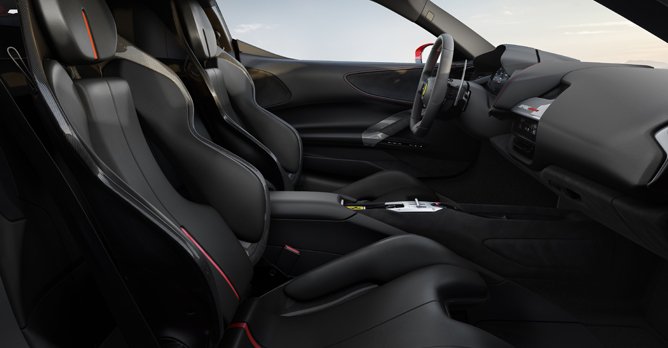
 The very explicit aim was to create a cockpit that ushered in an entirely new design direction, the effects of which would carry over into Ferrari's entire future range On the central tunnel, improved ergonomics have been combined with an element from the past. The automatic gearbox controls are now selected by a grille-style feature that references Ferrari's legendary manual gear-shift gate. Thus past and present skilfully merge to point the new Ferrari towards the future.
The very explicit aim was to create a cockpit that ushered in an entirely new design direction, the effects of which would carry over into Ferrari's entire future range On the central tunnel, improved ergonomics have been combined with an element from the past. The automatic gearbox controls are now selected by a grille-style feature that references Ferrari's legendary manual gear-shift gate. Thus past and present skilfully merge to point the new Ferrari towards the future.
Fully integrated into the car's vehicle dynamics controls, the RAC-e governs the distribution of torque, making driving on the limit much simpler and easier.

For maximum performance in terms of overall weight, rigidity and centre of gravity, the chassis and bodyshell of the SF90 Stradale is all new, built using multi-material technology, including, for example, carbon fibre. The development of a hybrid car of this kind demanded the development of a series of innovative aerodynamic solutions.
The significant boost in the power unit's performance brought with it an increase in the amount of heat energy to be dissipated and required the development team to carry out an in-depth review of the aerodynamic flows on the radiating masses. It also demanded new solutions to increase downforce efficiently and guarantee maximum stability at all speeds and in all driving conditions.
Particularly noteworthy is the innovative shut-off Gurney, a patented active system located at the rear of the car, which regulates the air flow over the upper body, reducing drag at high speeds with low lateral dynamics loads and increasing downforce in corners, under braking and during changes of direction.
The new car is epoch-changing from a stylistic perspective as it completely rewrites the mid-rear-engined sports berlinetta proportions introduced on the 360 Modena 20 years ago, instead taking its inspiration from Ferrari's recent supercars.
A good example is the cockpit, which has a smaller frontal section and is placed closer to the front of the car to reduce drag. This was also achieved without impacting on-board comfort.
The track-derived 'eyes on the road, hands on the wheel' philosophy takes on a truly central role for the first time too, significantly influencing the ergonomics and styling of the interior. The result is an HMI (Human-Machine Interface) and interior layout concept that are a complete departure from previous models.
Another major innovation is the steering wheel, which now has a touchpad and a series of haptic buttons that allow the driver to control virtually every aspect of the car using just their thumbs.
The central instrument cluster is now entirely digital with the first automotive application of a 16-inch curved HD screen, which can be fully configured and controlled using the controls on the steering wheel.

The SF90 Stradale also sees the debut of the new ignition key with full keyless technology, which will gradually be introduced across the rest of the range, personalised with the model's name. Thanks to a special compartment in the central tunnel, it becomes an integral part of the car's styling.
In addition to the sporty version, which references the shape and colour of the signature rectangular Prancing badge sported by Ferrari's road cars, there will also be a more elegant metal-coloured version. For the first time on a Ferrari, clients can choose between the standard car and a version with a more sports-oriented specification.
The Assetto Fiorano specification includes significant upgrades, including special GT racing-derived Multimatic shock absorbers, extra lightweight features made from high-performance materials such as carbon fibre (door panels, underbody) and titanium (springs, entire exhaust line), resulting in a weight-saving of 30kg.
Another difference is the high downforce carbon fibre rear spoiler, which generates 390kg of downforce at 250km/h. The Assetto Fiorano includes Michelin Pilot Sport Cup2 tyres designed specifically to improve performance on the track in the dry. They feature a softer compound and fewer grooves than the tyres provided as standard.
In addition to the sporty version, which references the shape and colour of the signature rectangular Prancing badge sported by Ferrari's road cars, there will also be a more elegant metal-coloured version. For the first time on a Ferrari, clients can choose between the standard car and a version with a more sports-oriented specification.
The Assetto Fiorano specification includes significant upgrades, including special GT racing-derived Multimatic shock absorbers, extra lightweight features made from high-performance materials such as carbon fibre (door panels, underbody) and titanium (springs, entire exhaust line), resulting in a weight-saving of 30kg.
Another difference is the high downforce carbon fibre rear spoiler, which generates 390kg of downforce at 250km/h. The Assetto Fiorano includes Michelin Pilot Sport Cup2 tyres designed specifically to improve performance on the track in the dry. They feature a softer compound and fewer grooves than the tyres provided as standard.
The new model is extreme on every level and represents a true paradigm shift, because it delivers unprecedented performance for a production car. Figures such as 986bhp and 390kg of downforce at 250km/h not only put the SF90 Stradale at the top of its segment, but also mean that a V8 is the top-of-the-range model for the first time in the marque's history.

A brilliant encapsulation of the most advanced technologies developed in Maranello, the SF90 Stradale is also the perfect demonstration of how Ferrari immediately transitions the knowledge and skills it acquires in competition to its production cars.
The SF90 Stradale has a 90-degree V8 turbo engine capable of delivering 769bhp, the highest power output of any eight-cylinder in Ferrari history. The remaining 217bhp is delivered by three electric motors, one at the rear, known as the MGUK (Motor Generator Unit, Kinetic) due to its derivation from the Formula One application, located between the engine and the new eight-speed dual-clutch transmission on the rear axle, and two on the front axle.
This sophisticated system does not, however, make for a more complicated driving experience. Quite the opposite, in fact - the driver simply has to select one of the four power unit modes, and then just concentrate on driving.
The sophisticated control logic takes care of the rest, managing the flow of power between the V8, the electric motors and the batteries.
The SF90 Stradale is also the first Ferrari sports car to be equipped with 4WD, a step necessary to allow the incredible power unleashed by the hybrid powertrain to be fully exploited, ensuring the car has become the new benchmark for standing starts: 0-100km/h in 2.5 sec and 0-200km/h in just 6.7 seconds.
Ferrari's engineers were able to further broaden the spectrum of dynamic controls by introducing the full-electric front axle, known as the RAC-e (electronic cornering set-up regulator). As well as exclusively providing propulsion in electric drive, the two front motors independently control the torque delivered to the two wheels, extending the concept of Torque Vectoring.
Fully integrated into the car's vehicle dynamics controls, the RAC-e governs the distribution of torque, making driving on the limit much simpler and easier.


The SF90 Stradale is now the new benchmark for downforce and efficiency in high-performance road cars The introduction of this hybrid architecture was a challenge with regard to managing the additional weight which was resolved by an obsessive attention to detail and the overall optimisation of the whole of the car.
For maximum performance in terms of overall weight, rigidity and centre of gravity, the chassis and bodyshell of the SF90 Stradale is all new, built using multi-material technology, including, for example, carbon fibre. The development of a hybrid car of this kind demanded the development of a series of innovative aerodynamic solutions.
The significant boost in the power unit's performance brought with it an increase in the amount of heat energy to be dissipated and required the development team to carry out an in-depth review of the aerodynamic flows on the radiating masses. It also demanded new solutions to increase downforce efficiently and guarantee maximum stability at all speeds and in all driving conditions.
Particularly noteworthy is the innovative shut-off Gurney, a patented active system located at the rear of the car, which regulates the air flow over the upper body, reducing drag at high speeds with low lateral dynamics loads and increasing downforce in corners, under braking and during changes of direction.
The new car is epoch-changing from a stylistic perspective as it completely rewrites the mid-rear-engined sports berlinetta proportions introduced on the 360 Modena 20 years ago, instead taking its inspiration from Ferrari's recent supercars.
A good example is the cockpit, which has a smaller frontal section and is placed closer to the front of the car to reduce drag. This was also achieved without impacting on-board comfort.
The track-derived 'eyes on the road, hands on the wheel' philosophy takes on a truly central role for the first time too, significantly influencing the ergonomics and styling of the interior. The result is an HMI (Human-Machine Interface) and interior layout concept that are a complete departure from previous models.
Another major innovation is the steering wheel, which now has a touchpad and a series of haptic buttons that allow the driver to control virtually every aspect of the car using just their thumbs.
The central instrument cluster is now entirely digital with the first automotive application of a 16-inch curved HD screen, which can be fully configured and controlled using the controls on the steering wheel.


The very explicit aim was to create a cockpit that ushered in an entirely new design direction, the effects of which would carry over into Ferrari's entire future range On the central tunnel, improved ergonomics have been combined with an element from the past. The automatic gearbox controls are now selected by a grille-style feature that references Ferrari's legendary manual gear-shift gate. Thus past and present skilfully merge to point the new Ferrari towards the future.
Fully integrated into the car's vehicle dynamics controls, the RAC-e governs the distribution of torque, making driving on the limit much simpler and easier.

The SF90 Stradale is now the new benchmark for downforce and efficiency in high-performance road cars
For maximum performance in terms of overall weight, rigidity and centre of gravity, the chassis and bodyshell of the SF90 Stradale is all new, built using multi-material technology, including, for example, carbon fibre. The development of a hybrid car of this kind demanded the development of a series of innovative aerodynamic solutions.
The significant boost in the power unit's performance brought with it an increase in the amount of heat energy to be dissipated and required the development team to carry out an in-depth review of the aerodynamic flows on the radiating masses. It also demanded new solutions to increase downforce efficiently and guarantee maximum stability at all speeds and in all driving conditions.
Particularly noteworthy is the innovative shut-off Gurney, a patented active system located at the rear of the car, which regulates the air flow over the upper body, reducing drag at high speeds with low lateral dynamics loads and increasing downforce in corners, under braking and during changes of direction.
The new car is epoch-changing from a stylistic perspective as it completely rewrites the mid-rear-engined sports berlinetta proportions introduced on the 360 Modena 20 years ago, instead taking its inspiration from Ferrari's recent supercars.
A good example is the cockpit, which has a smaller frontal section and is placed closer to the front of the car to reduce drag. This was also achieved without impacting on-board comfort.
The track-derived 'eyes on the road, hands on the wheel' philosophy takes on a truly central role for the first time too, significantly influencing the ergonomics and styling of the interior. The result is an HMI (Human-Machine Interface) and interior layout concept that are a complete departure from previous models.
Another major innovation is the steering wheel, which now has a touchpad and a series of haptic buttons that allow the driver to control virtually every aspect of the car using just their thumbs.
The central instrument cluster is now entirely digital with the first automotive application of a 16-inch curved HD screen, which can be fully configured and controlled using the controls on the steering wheel.

The very explicit aim was to create a cockpit that ushered in an entirely new design direction, the effects of which would carry over into Ferrari's entire future range
The SF90 Stradale also sees the debut of the new ignition key with full keyless technology, which will gradually be introduced across the rest of the range, personalised with the model's name. Thanks to a special compartment in the central tunnel, it becomes an integral part of the car's styling.
In addition to the sporty version, which references the shape and colour of the signature rectangular Prancing badge sported by Ferrari's road cars, there will also be a more elegant metal-coloured version. For the first time on a Ferrari, clients can choose between the standard car and a version with a more sports-oriented specification.
The Assetto Fiorano specification includes significant upgrades, including special GT racing-derived Multimatic shock absorbers, extra lightweight features made from high-performance materials such as carbon fibre (door panels, underbody) and titanium (springs, entire exhaust line), resulting in a weight-saving of 30kg.
Another difference is the high downforce carbon fibre rear spoiler, which generates 390kg of downforce at 250km/h. The Assetto Fiorano includes Michelin Pilot Sport Cup2 tyres designed specifically to improve performance on the track in the dry. They feature a softer compound and fewer grooves than the tyres provided as standard.
In addition to the sporty version, which references the shape and colour of the signature rectangular Prancing badge sported by Ferrari's road cars, there will also be a more elegant metal-coloured version. For the first time on a Ferrari, clients can choose between the standard car and a version with a more sports-oriented specification.
The Assetto Fiorano specification includes significant upgrades, including special GT racing-derived Multimatic shock absorbers, extra lightweight features made from high-performance materials such as carbon fibre (door panels, underbody) and titanium (springs, entire exhaust line), resulting in a weight-saving of 30kg.
Another difference is the high downforce carbon fibre rear spoiler, which generates 390kg of downforce at 250km/h. The Assetto Fiorano includes Michelin Pilot Sport Cup2 tyres designed specifically to improve performance on the track in the dry. They feature a softer compound and fewer grooves than the tyres provided as standard.
Latest COE Prices
May 2025 | 1st BIDDING
NEXT TENDER: 21 May 2025
CAT A$103,009
CAT B$119,890
CAT C$62,590
CAT E$118,889
View Full Results Thank You For Your Subscription.
